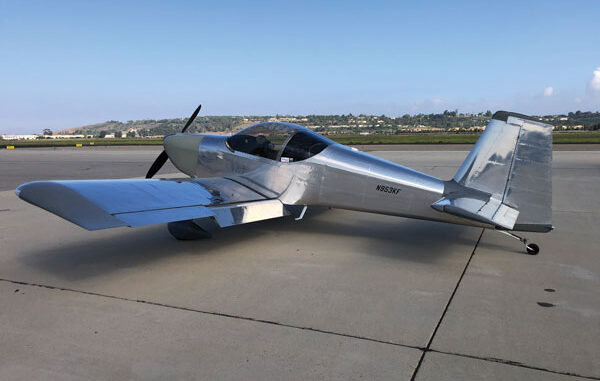
By Ken Taylor, EAA 637372
After a long career in the Navy flying turboprops and helicopters, and several more years flying turboprops in government contract work internationally, I realized I didn’t want to give up flying, but I was a bit old for long flight missions during the dark hours. I decided to retire from the international work and get my own wings. I wanted an airplane that flew fast with good IFR cross-country capabilities, as well as one that would do aerobatics — simple maneuvers like I enjoyed in my earliest days as a Navy instructor flying T-34Cs. Finding and affording a certified airplane for both traveling and aerobatics was not possible, but the RV-14 was the perfect choice.
N953KF took four years and two months from first rivet to first flight. I began with two weeks of assistance and training in assembling the empennage at Synergy Air, in Eugene, Oregon. My dear wife was skeptical but supportive. When I suggested I would begin building in our garage, she quickly claimed that space as her art studio, leading me to buy the perfect hangar. I brought the empennage home to my hangar in Camarillo, California (KCMA), ordered quick-build wings and fuselage kits, bought a Cleaveland Tools RV-14 tool kit, and began building. The whole family and several friends helped along the way, but my principal partner was my youngest adult son, Fletcher. He and I got pretty good at riveting and wrenching over those four years.
After a demoralizing prop strike incident that delayed the first flight by six months, I got airborne in March 2023. The standard 210-hp YIO-390 has plenty of power to pull the light airframe. The G3X avionics suite with a great autopilot is superbly stable and very comforting to fly coupled precision approaches to minimums in IMC. I get 170 knots true airspeed at 6,500 feet, on 11 gph. Climb performance is great — 1,500 feet per minute through 5,000 feet. Within weight and balance limits, I can fly with full fuel (300 pounds) and baggage (100 pounds) and a 230-pound friend. The airplane can fly for more than four hours with full fuel, but my 70-year-old body prefers no more than three-hour legs. I’ve begun flying some aerobatic maneuvers, and logging successes as required before taking along passengers. The view thorough the huge canopy is incredible at the inverted top of a loop. My wife has named 3KF Zippy, and that is perfectly descriptive.
I flew 3KF to AirVenture Oshkosh last year, visiting family and friends along the way. I now have more than 100 flight hours on it, without significant issues, but I still cannot decide on a paint scheme.

Attention — Aircraft Builders and Restorers
We would love to share your story with your fellow EAA members in the pages of EAA Sport Aviation magazine, even if it’s a project that’s been completed for a while. Readers consistently rate the “What Our Members are Building/Restoring” section of the magazine as one of their favorites, so don’t miss the chance to show off your handiwork and inspire your peers to start or complete projects of their own. Learn more ->
